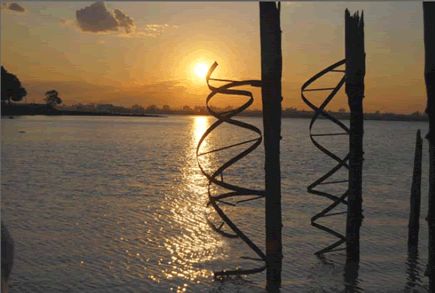
New York City’s First Pilot Project to Grow Solar-Powered Oyster Reefs to be launched on Sunday, July 1 on Queens Waterfront
Oysters to be affixed to series of sculptures depicting double-helix DNA in the act of replication by Brooklyn artist Mara Haseltine and being installed at MacNeil Park in College Point, Northeast Queens
NEW YORK CITY, June 25 — A team of marine biologists is embarking on an innovative and optimistic project to literally jump-start the city’s oyster population and will launch the pilot projectwhich combines art and science–on Sunday, July 1, at 5:30 p.m. at MacNeil Park in College Point, Queens.
Pace University professor and Marine Pathologist Dr. James M. Cervino is spearheading the project, teaming with Brooklyn-based sculptor Mara Haseltine, Global Coral Reef Alliance President Dr. Thomas J. Goreau and Columbia University graduate student Kaitlin Baird.
“This will be like a mini-water treatment plant, only operated by nature,” said Cervino, who is also President of the nonprofit Coastal Preservation Network, an organization dedicated to cleaning and protecting the health of the Queens coastline. “Oysters filter and clean the seawater, and our project should allow for oysters to flourish in quantities that New York City hasnt seen in many decades.”
The project will employ a mineral accretion process known as Biorock, which uses low voltage, direct-current electricity to grow solid limestone underwater. The electrical current causes minerals that are naturally dissolved in seawater to precipitate and adhere to a metal structure, and the resulting limestone has a strength similar to that of concrete.
Biorock is a patented process co-designed by Goreau that has been used in coastal areas all over the world to replenish coral reefs and accelerate their growth, giving them extra energy that allows them to survive in conditions that would otherwise kill them. This technology has also been successfully applied to growing limestone breakwaters to protect islands and coastal areas from erosion and rising sea levels. At MacNeil Park, Biorock will be used to accelerate the growth of oysters.
On Sunday, seedling oysters will be affixed to two double-helix-shaped metal sculptures created by Haseltine in her Brooklyn studio. The sculptures will be mounted to old pilings that stand in the waters off the northeast shoreline of MacNeil Park. Interestingly, the pilings once supported the dock for a ferry that ran between College Point and the Bronx but ceased operation after the Bronx-Whitestone Bridge was built in 1939.
Haseltine said the double-helix shapes will bring both aesthetic beauty and optimal functionality to the project, and will double as teaching tools. Entitled “Transcriptease,” the sculptures depict DNA in the act of replication. One sculpture is a fully formed DNA helix, and the other depicts the DNA in the act of unraveling into the two separate strands of messenger RNA (mRNA).
“To create the ultimate shape for oysters to grow on I turned to Mother Nature as my muse,” said Haseltine, whose science-inspired sculptures stand throughout the world. “The double helix shape is perfect because it allows for water to flow freely around it, thus allowing oysters to receive the maximum amount of nutrients. In a typical oyster midden the oysters pile on top of each other so the ones on the bottom literally starve”
Oysters filter up to 25 gallons of water a day and act as natural filtration systems, providing a significant step toward a cleaner waterfront, Goreau said. Oysters once inhabited more than 350 square miles of water around the city, but have been nearly wiped out by pollution and over-harvesting in the last century.
In the College Point project, the goal is for oysters to grow at faster rates and to multiply, cleaning the waters and attracting further biodiversity in this previously polluted and distressed area, Cervino said. If the project is successful, Cervino and Goreau plan to replicate it at other locations around the city in hopes of reigniting biodiversity in waters where it has long languished. Previous attempts at bolstering the oyster population in city waters using more traditional methods, including an expansive project at the Statue of Liberty in 2003, have seen only limited success.
Cervino, a College Point native, said adding aesthetic value, particularly in the form of a double helix, will enable the team to use the project as an effective teaching tool for students from local elementary schools, high schools, and colleges, who will be encouraged to visit the site. Haseltines artwork is visually compelling and makes complex scientific concepts more accessible to the masses. Her largest sculpture to date the 84 foot long, Waltz of the Polypeptides depicting a sub-cellular organelle called a ribosome creating a protein which was donated last October to the Cold Spring Harbor Campus, in Cold Spring Harbor Long Island, the international science Mecca founded by Chancellor James Watson, co-discover of the double helix. This work is the first in a series she is creating called in a series of environmental works she calls living sculptures, which will help heal the planet.
This project is incredibly unique and will provide a rich learning experience on several levels for students and adults alike, Cervino said. We look forward to a flourishing oyster population in College Point and to providing people with the opportunity to witness something that hasn’t taken place anywhere else in New York City.